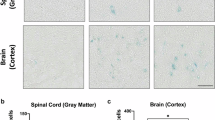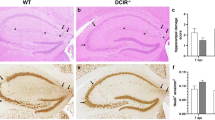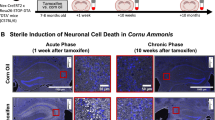Abstract
Mouse hepatitis virus type 4 (MHV-4, the JHM strain), a positive-strand RNA virus of the coronavirus family, is well documented as an inducer of acute1–4 and chronic5,6 demyelination in mice, as well as subacute demyelination in rats7,8, due to a cytolytic infection of oligodendrocytes3,4,7. However, experiments to explore the role of virus and host factors in the production of chronic or recurrent demyelinating disease have been limited because MHV-4 usually produces demyelination in conditions that frequently induce a fatal necrotizing encephalomyelitis1–9. To circumvent this problem, we had made and selected mutant viruses that caused both a high incidence of demyelination and a low incidence of encephalitis-induced mortality9. One such mutant, designated ts8, consistently caused acute demyelinating disease in over 90% of intracerebrally or intranasally (natural route of infection) inoculated, 4–5 week-old mice from several susceptible strains within 6–10 days9,10. In addition, ts8 typically did not cause fatal necrotizing encephalitis, showing a low mortality (<5%)9,10. This reflected a unique tropism of ts8 for oligodendrocytes, but a limited one for neuronal cells11. We now report that ts8 is also useful for inducing persistent infection of the mouse central nervous system (CNS). The histopathological correlate of this infection is chronic recurrent demyelination, and virus can be demonstrated ultrastructurally in intact oligodendrocytes, in the vicinity of demyelinated areas.
This is a preview of subscription content, access via your institution
Access options
Subscribe to this journal
Receive 51 print issues and online access
$199.00 per year
only $3.90 per issue
Buy this article
- Purchase on SpringerLink
- Instant access to full article PDF
Prices may be subject to local taxes which are calculated during checkout
Similar content being viewed by others
References
Bailey, O. T., Pappenheimer, A. M., Cheever, F. S. & Daniels, J. B. J. exp. Med. 90, 195–212 (1949).
Waksman, B. H. & Adams, R. D. J. Neuropath. exp. Neurol. 21, 491–518 (1962).
Lampert, P. W., Sims, J. K. & Kniazeff, A. J. Acta Neuropath. 24, 76–85 (1973).
Weiner, L. P. Archs Neurol. 28, 298–303 (1973).
Herndon, R. M., Griffin, D. E., McCormick, V. & Weiner, L. P. Archs Neurol. 32, 32–35 (1975).
Stohlman, S. A. & Weiner, L. P. Neurology 31, 38–44 (1981).
Nagashima, K., Wege, H., Meyermann, R. & ter Meulen, V. Acta neuropath. 44, 63–70 (1978).
Sorensen, O., Perry, D. & Dales, S. Archs Neurol. 37, 478–484 (1980).
Haspel, M. V., Lampert, P. W. & Oldstone, M. B. A. Proc. natn. Acad. Sci. U.S.A. 75, 4033–4036 (1978).
Lampert, P. W., Haspel, M. V. & Oldstone, M. B. A. in Progress in Multiple Sclerosis Research (eds Bauer, H. J., Poser, S. & Ritter, G.) 35–39 (Springer, Berlin, 1980).
Knobler, R. L. et al. J. Neuroimmun. 1, 81–92 (1981).
Knobler, R. L., Haspel, M. V. & Oldstone, M. B. A. J. exp. Med. 153, 832–843 (1981).
Maugh, T. H. II, Science 195, 667–669, 768–771, 969–971 (1977).
Author information
Authors and Affiliations
Rights and permissions
About this article
Cite this article
Knobler, R., Lampert, P. & Oldstone, M. Virus persistence and recurring demyelination produced by a temperature-sensitive mutant of MHV-4. Nature 298, 279–280 (1982). https://doi.org/10.1038/298279a0
Received:
Accepted:
Issue date:
DOI: https://doi.org/10.1038/298279a0
This article is cited by
-
Viral mouse models used to study multiple sclerosis: past and present
Archives of Virology (2021)



